About Bhutan (Druk)
 Nestled in the eastern Himalayas, Bhutan (also called as Druk – the Dragon Kingdom) is a small land locked country located between China and India and has successfully maintained its identity since long. Bhutan has been increasingly seen as tourist hotspots due to its rich spiritual and cultural heritage, supported by the development philosophy of Gross National Happiness (GNH).
Nestled in the eastern Himalayas, Bhutan (also called as Druk – the Dragon Kingdom) is a small land locked country located between China and India and has successfully maintained its identity since long. Bhutan has been increasingly seen as tourist hotspots due to its rich spiritual and cultural heritage, supported by the development philosophy of Gross National Happiness (GNH).
Further, Bhutan has an astounding biodiversity, and a dense forest cover of more than 70% with an extensive protected areas network, comprising more than 50% of the country. Infact Bhutan is also known as a carbon negative country.
Gross National Happiness
 Gross National Happiness (GNH) was crafted by The fourth King of Bhutan Jigme Singye Wangchuk in the late 1980s to define Bhutan’s development objective as improvement in the happiness and satisfaction of the people rather than growth of Gross National Product (GNP). GNH gained its place in the national planning as erstwhile Planning Commission was renamed as GNH Commission in 2008. GNH take hold of a sustainable balance between the economic, social, spiritual and cultural needs of the people.
Gross National Happiness (GNH) was crafted by The fourth King of Bhutan Jigme Singye Wangchuk in the late 1980s to define Bhutan’s development objective as improvement in the happiness and satisfaction of the people rather than growth of Gross National Product (GNP). GNH gained its place in the national planning as erstwhile Planning Commission was renamed as GNH Commission in 2008. GNH take hold of a sustainable balance between the economic, social, spiritual and cultural needs of the people.
Gross National Happiness has recently received international recognition and the UN has implemented a resolution on GNH. Basically GNH in Bhutan revolves around the four pillars of; i) Equitable and equal socio-economic development, ii) Conservation of environment, iii) Preservation and promotion of cultural and spiritual heritage and iv) Good governance.
History
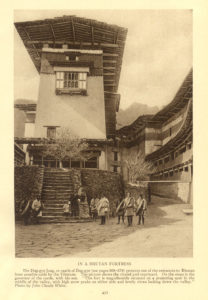 Early history of Bhutan remains obscure. Some say that the name ‘Bhutan’ has been derived from the Sanskrit term ‘Bhot-ant’ meaning ‘end of Bhot’ or from ‘Bhu-uttan’ meaning ‘high land’. Though known as Bhutan to the outside world, the Bhutanese themselves refer to their country as Druk Yul or the Land of the Thunder Dragon. Three important personalities have significance in shaping Bhutanese history.
Early history of Bhutan remains obscure. Some say that the name ‘Bhutan’ has been derived from the Sanskrit term ‘Bhot-ant’ meaning ‘end of Bhot’ or from ‘Bhu-uttan’ meaning ‘high land’. Though known as Bhutan to the outside world, the Bhutanese themselves refer to their country as Druk Yul or the Land of the Thunder Dragon. Three important personalities have significance in shaping Bhutanese history.
The first figure being the great Indian Tantric Saint, Guru Padma Sambhava who came to Bhutan on the invitation of the then King of Bumthang, Sindhu Raja and also his journey to Paro Taktshang on a tigress in a wrathful form to spread Buddhism. He has blessed the country as “Baeyul”- a hidden land of treasures.
The second important figure is a Tibetan Re-incarnate Lama Zhabdrung Ngawang Namgyel, who unified the country and established a dual system of governance in the 17th Century. Prior to his arrival history accounts that Bhutan was having several feudal chiefs ruling different regions in the country, often leading to constant conflicts.
After arriving in Bhutan from Tibet he consolidated his power, defeated several Tibetan invasions and established a comprehensive system of law and governance. He built several Dzongs in the country and established the Drukpa Kagyud school of Buddhism. He named the country as “Drukyul” and the people as “Drukpa”. Later after his death the country fell into in-fighting and civil war between the various local rulers again erupted.
The third most important figure in shaping Bhutanese history has been the Wangchuck Dynasty which has started with the enthronment of Trongsa Penlop Ugyen Wangchuck in 1907 in Punakha as the first hereditary ruler of Bhutan, thus establishing the Wangchuck dynasty that still rules today. The current King, His Majesty Jigme Khesar Namgyal Wangchuck is the fifth king of Bhutan. The country opened up to modern development since 1960s and has progressed enormously.
People and culture
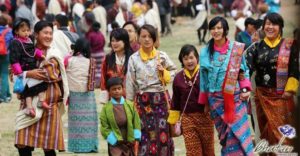 Bhutan has aptly been referred to as “The Last Shangri-la” due to its largely unspoilt natural environment and cultural heritage. Bhutanese tradition and culture is deeply rooted in Buddhist heritage.
Bhutan has aptly been referred to as “The Last Shangri-la” due to its largely unspoilt natural environment and cultural heritage. Bhutanese tradition and culture is deeply rooted in Buddhist heritage.
Earliest settlers of Bhutan are “Monpa” who have been settled in pockets of Trongsa and Wangduephodrang district, speaking distinct dialect. Apart from Monpa there are different ethnic groups of people residing in various parts of Bhutan. For easy reference Bhutan has been broadly divided into three;– Sharchops, Ngalops and Lhotshampas – based on the regions settled.
The Sharchops inhabit the Eastern part of Bhutan and the common language spoken is called as “Tshangla” the language of the God. Ngalops, are the descendants of Tibetan immigrants who came to Bhutan in 8th and 9th century A.D settling primarily in the west and their language which is called as Dzongkha is bit similar to Tibetan. Lhotshampas, representing the Nepali speaking ethnic group forms the third group and inhabits the southern foothills of Bhutan. They are mostly Hindus whereas the Sharchops and Ngalops are Buddhists.
The Bhutanese people are commonly called as Drukpa and the national language is Dzongkha. Administratively it has been divided into 20 districts. Bhutanese wear distinctive national dress and the men’s attire is called ‘Gho’ and ladies attire is called ‘Kira’ and are put on during official and formal occasions. The monastic system where in the religious group of people resides play a critical role in Bhutanese system. Each and every Bhutanese have altar as a prayer room. The staple food of Bhutan consists of rice and the most popular dish in Bhutan is called ‘Ema Datse’ which is made from cheese and chilies. Chang, a local alcohol is made from maize and is a common drink especially in the villages. Chang is a local spirit brewed from rice or corn. It is popular in rural areas. Both Sweet milk tea and Suja – a salted butter tea are enjoyed with meals and in the evenings. Tea is the first things Bhutanese people offer to guests visiting their homes.
The most amazing and fascinating about Bhutan is its unique cultural identity which has been preserved due to its self-imposed isolation from the rest of the world until the early 1960s. The Bhutanese tradition today despite embarking on modern development since early 1960 is still deeply rooted in Buddhist values. Various folk dances, ancient music and the mask dances are performed during various occasions. Traditional Bhutanese arts and crafts, commonly called as the Zorig Chusom -13 traditional crafts of Bhutan have deep religious, spiritual and cultural significance and each one reflects the Bhutanese way of life.
Geography
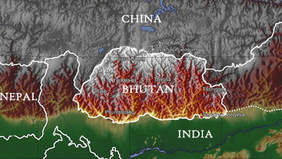 Bhutan is located in Eastern Himalayas and is located between China towards the North and India from the remaining sides. Bhutan is approximately 300km long and 150km wide, with an overall size of 38,394 square kilometres. Most of the country is under forest cover (more that 70%) of the country is under forest cover. Its landscape consists of a succession of lofty and rugged mountain ranges separated by deep valleys. Northern part of Bhutan is bound by the snow capped mountains that reaches a height of over 7500 meters above sea level. The northern belt is inhabited by few nomads and yak herders who move to the warmer places in the winter and bring back their livestock for grazing in the summer.
Bhutan is located in Eastern Himalayas and is located between China towards the North and India from the remaining sides. Bhutan is approximately 300km long and 150km wide, with an overall size of 38,394 square kilometres. Most of the country is under forest cover (more that 70%) of the country is under forest cover. Its landscape consists of a succession of lofty and rugged mountain ranges separated by deep valleys. Northern part of Bhutan is bound by the snow capped mountains that reaches a height of over 7500 meters above sea level. The northern belt is inhabited by few nomads and yak herders who move to the warmer places in the winter and bring back their livestock for grazing in the summer.
The inner Himalayas with elevation ranging from 1000 meters to 3500 meters have major towns like Thimphu, Paro, Punakha. The Southern Hills are covered with dense deciduous forest, alluvial lowland river valleys, and mountains that reach around 1,500 meters above sea level. The Southern Foothills in the have dense vegetation and abundant wildlife. The border towns are all in the southern foothills which shares borders with India.
Climate and weather
Geographically Bhutan can be divided into three distinct regions or climatic zones: Southern, Central and Northern.
Northern part of Bhutan which shares international borders with Tibet is mostly covered with snow, with more prolonged winter months and shorter summer months. The ranges of this region are normally covered with snow and are therefore difficult to access during winter. Bhutan’s high altitude trekking routes are found in this area.
The Central region lies within the Inner Himalayas and consists of higher mountains. The climate of this region is moderate at lower elevation as in Punakha and Wangdi Phodrang and rather cold in higher elevations, especially during the night time. Daytime temperatures are pleasant even in the higher altitudes. The annual rainfall is moderate. Owing to the presence of fertile valleys, the majority of the country’s agriculture is confined to this region.
The Southern region bordering with India has a sub-tropical monsoon climate. Its annual rainfall is excessive, and the average temperature stands at 20 C. The climate of this region is hot and humid during summer, but pleasant during winter time. Overall Summer months tend to be wetter, Winter by far the driest period while spring and autumn tend to be pleasant.
Floral and Faunal diversity
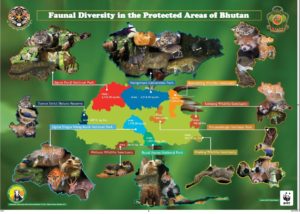 Bhutan falls within the Eastern Himalayan Biodiversity hotspots of the world and has over 70 % of its total land area under forest cover. The government has made a pledge to maintain a total forest cover of 60 % for all times to come. More than 50% of the country’s area is protected through National Parks and Biological Corridor.
Bhutan falls within the Eastern Himalayan Biodiversity hotspots of the world and has over 70 % of its total land area under forest cover. The government has made a pledge to maintain a total forest cover of 60 % for all times to come. More than 50% of the country’s area is protected through National Parks and Biological Corridor.
The inventories have indicated that there are more than 5,500 species of vascular plants, more than 700 species of avifauna and more than 165 species of mammals, with many species being endemic to Bhutan. The various species of plants include 300 species of medicinal plants, 46 species of Rhododendron, 600 Orchid species.
To name few animals; Along its southern border, Asiatic elephant, greater one-horned rhinoceros, gaur, wild water buffalo, hog deer, tiger, clouded leopard and other mammals and birds characteristic of indomalayan species are found. Blue sheep, takin, musk deer, snow leopard, wolf and other species characteristic of the Palearctic realm are found towards the north. More than 700 species of birds have been recorded in Bhutan which reflects the Kingdom’s wide range of agro-ecological environments – from subtropical to alpine and its location at the northern edge of the Zoogeographical oriental region and the permeable and fluid border with China. Also country is home to the near extinct White Bellied Heron numberig 28 are and is also winter habitat for black-necked crane. Bhutan is also home to about 16 bird species that are endangered worldwide.
Economy
Bhutan is categorized as a least developed country. Agriculture is still the dominant sector providing livelihood, income and employment to more than 69% percent of the total population. Bhutan has many fresh water system which is used for generating hydro power resources and the majority of electricity is exported to India. Hydro power is the largest contributor to economy and still has the capacity to generate about 30,000 MW of electricity and many hydro power projects are underway. Fueled by the development of hydro power, the industrial sector (small scale and cottage industries) are on the rise.
The tourism industry with a policy of “High value, Low impact” plays an important role in Bhutan’s socio-economic development as the largest commercial source of convertible currency earnings. Infact its location, terrain and relative isolation have provided a strong comparative advantage as a special destination, which has been fuelled by its developmental philosophy of Gross National Happiness.
National symbol
Despite the diversity within the small country, Bhutan is united as a country and the following national symbol are recognized nationally and everybody knows regarding its significance.
National Flag
 The National flag is divided diagonally into two halves. The upper yellow half signifies the secular power and authority of the king while the lower saffron-orange symbolizes the practice of religion and power of Buddhism manifested in the tradition of Drukpa Kagyu. The dragon signifies the name, its white colour signifies the purity, while the jewels stand wealth and perfection of the country.
The National flag is divided diagonally into two halves. The upper yellow half signifies the secular power and authority of the king while the lower saffron-orange symbolizes the practice of religion and power of Buddhism manifested in the tradition of Drukpa Kagyu. The dragon signifies the name, its white colour signifies the purity, while the jewels stand wealth and perfection of the country.
National Emblem
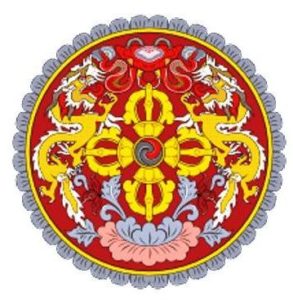 The National Emblem of Bhutan is a circle that projects a double diamond thunderbolt placed above lotus encircled by two dragons. The thunderbolt represent the harmony between secular and religious power while the lotus symbolises purity. The jewel signifies the sovereign power while the two dragons (male and female) represent the name of the country Druk Yul, the land of the Dragon.
The National Emblem of Bhutan is a circle that projects a double diamond thunderbolt placed above lotus encircled by two dragons. The thunderbolt represent the harmony between secular and religious power while the lotus symbolises purity. The jewel signifies the sovereign power while the two dragons (male and female) represent the name of the country Druk Yul, the land of the Dragon.
National Sport
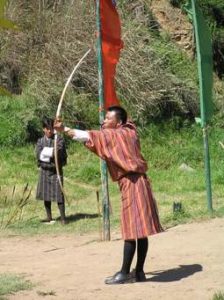 The National sport is the Archery (locally called as Da). As such the bow and arrow play a significant role in many Bhutanese myths and legends with images of statue holding bow and arrow considered favourable. Normally 11 team members on each side plays against each other. While the men plays the archery the women group come to the ground with pot luck lunches and they also dance traditional folk songs. Infact Bhutanese athlete goes to the Olympic games to compete in archery games.
The National sport is the Archery (locally called as Da). As such the bow and arrow play a significant role in many Bhutanese myths and legends with images of statue holding bow and arrow considered favourable. Normally 11 team members on each side plays against each other. While the men plays the archery the women group come to the ground with pot luck lunches and they also dance traditional folk songs. Infact Bhutanese athlete goes to the Olympic games to compete in archery games.
National Tree
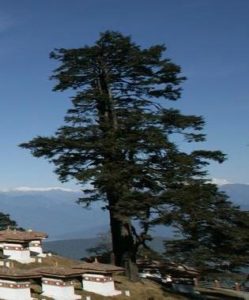 Cypresses (Cupressus torulosa) grown in the temperate zone, between 1800 and 3500 metres altitude is the National Tree of Bhutan. It has great religious significance.
Cypresses (Cupressus torulosa) grown in the temperate zone, between 1800 and 3500 metres altitude is the National Tree of Bhutan. It has great religious significance.
National Bird
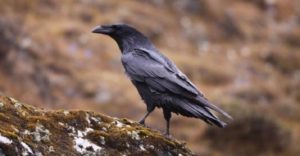 Raven (Corvus corax) is the national bird of Bhutan. Raven is significantly also represented as the chief guardian deity of Bhutan, Gonpo Jarodongchen (raven headed Mahakala). It is also used as the Royal crown.
Raven (Corvus corax) is the national bird of Bhutan. Raven is significantly also represented as the chief guardian deity of Bhutan, Gonpo Jarodongchen (raven headed Mahakala). It is also used as the Royal crown.
National Animal
 Bhutan Takin (Budorcas taxicolor whitei) is the national animal of Bhutan and live in groups. They live at higher altitude above 4000m above sea level during summer and migrate to warmer places during winter. It is associated with religious history and mythology.
Bhutan Takin (Budorcas taxicolor whitei) is the national animal of Bhutan and live in groups. They live at higher altitude above 4000m above sea level during summer and migrate to warmer places during winter. It is associated with religious history and mythology.
The National Flower
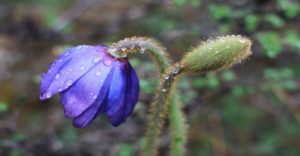 Blue Poppy (Meconopsis gakyidiana)which grows at higher altitude (3500 – 4500m) is the National Flower and was first discovered in 1933 by a British Botanist, George Sherif in a remote part of Sakteng in Eastern Bhutan.
Blue Poppy (Meconopsis gakyidiana)which grows at higher altitude (3500 – 4500m) is the National Flower and was first discovered in 1933 by a British Botanist, George Sherif in a remote part of Sakteng in Eastern Bhutan.
